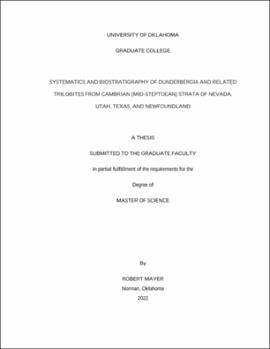| dc.description.abstract | The Great Basin of Nevada and Utah has been a classic region for Cambrian geology and paleontology for some 150 years. Studies in the late 19th century were prompted by the discovery of commercial ore deposits and led to the initial documentation of the trilobite faunas in the 1870s and 1880s. Further work on these faunas in the 1950s and early 1960s cemented the importance of the region, particularly as a standard succession for Cambrian trilobite biostratigraphy. However, many species are poorly documented by modern standards, and a revision is long overdue. This thesis focuses on the Dunderberg Formation in Nevada and coeval parts of the Orr Formation in Utah. With more than 100 trilobite species reported from the Dunderberg alone, a full revision of the fauna will not be attempted. Instead, the thesis deals with three genera of Family Elviniidae, Dunderbergia Walcott, 1924 and two close relatives, Dytremacephalus Palmer, 1954 and Elburgia, Palmer, 1960, and is based on new field collections from the Dunderberg and Orr formations. In addition, some species from the Riley Formation of central Texas and the Shallow Bay Formation of western Newfoundland are included in the study. A total of 18 species are documented, and eight of them are new. An analysis using computer- based parsimony methods places the species in a broader phylogenetic context. The results indicate that species of Dytremacephalus and Elburgia form monophyletic subclades that are nested within a set of species that have been assigned to Dunderbergia in previous studies; Dunderbergia is paraphyletic. An improved understanding of the relationships of these species must await a much larger analysis of the entire Family Elviniidae, a major undertaking that is beyond the scope of this thesis. As an interim step that preserves as much of the existing classification as possible, Dytremacephalus and Elburgia are treated as subgenera of Dunderbergia, with species of the latter referred to simply as Dunderbergia sensu lato. New species named in this thesis are: Dunderbergia (s.l.) astroplethes, Du. (s.l.) bovicephala, Du. (s.l.) multichauna, Du. (Dytremacephalus) aphropeca, Du. (Dy.) chondramma, Du. (Dy.) craniophysa, Du. (Dy.) pluviguttata, and Dunderbergia (Elburgia) magnatubercula. Species range data are used to develop a high- resolution zonation of four zones for the upper Candland Shale and correlatives in Nevada and Utah, in ascending order, the Du. (Dy.) pluviguttata, Prehousia alata, Dunderbergia (s.l.) anyta, and Dunderbergia (Elburgia) granulosa zones. They will allow detailed correlation of strata throughout the Great Basin region. | en_US |
